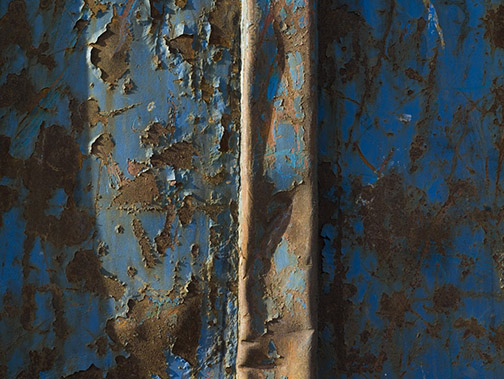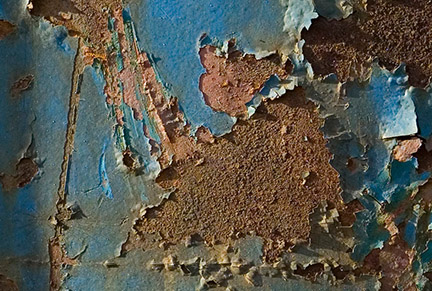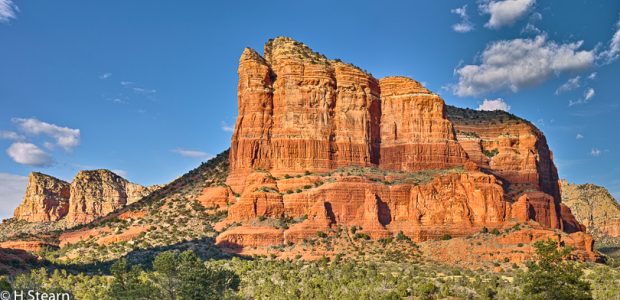By: Eduard de Kam
The way the ZD is designed could lead to a false assumption – that it is a camera that can be used handheld like a 35 mm DSLR. But with 22 million pixels and the resulting high image quality even the smallest errors will be seen in the resulting image. And though I have had reasonable to perfect results with the use of a Hasselblad H1D in the same fashion, I was not content with the handheld shots made with the ZD. Using a 200 mm lens and a shutter-speed of 1/320 sec I did not expect to have problems, but unfortunately, this was not the case. (Pentax 67 like mirror and shutter vibration issues? –Ed)
This is a photograph of an old container.
There are nice saturated blues in the shadows, sharp detail in the sunny parts.
Lens: 80 mm; Aperture: 5,6; exposure: 1/200.
There is also a detail crop below that shows the quality of the camera at 100%.
Clicking on either of these files will display a larger version.
Most shots takenhand held were lost due to movement of the camera. So a tripod it will have to be for this camera. That will of course give you all the freedom you need to use smaller apertures if there is to be more than shallow DOF. The higher ISO settings, 200 and 400, will have some noise, so they are better not to be used to get more DOF. When using the camera on a tripod there is a convenient button to do mirror lock-up, giving you even more certainty of getting a sharp image. Another thing that could lead to the assumption mentioned before is the option to get JPEG direct from the camera, bypassing RAW conversion software. It might be useful occasionally, but as such I would not miss it on a camera like this. The ZD is not build for the kind of hurry you normally are in if you resort to jpeg shooting.
Lens: 80 mm; Aperture: f/5.6; exposure: 1/200.
______________________________________________________________________
Weight
The size suggests a rather heavy camera, but when picking it up the weight is not much more then that of a Canon 1 Series DSLR. Some lenses will even be lighter than their Canon equivalents, thanks in part to smaller maximum apertures.
The LCD screen on the back offers all of the information needed for normal use. Not only is there a highlight warning, but a shadow warning is added as well when reviewing the images. The screen is not big, and in relation to the size of the camera it’s actually quite small.
Using the menus is rather straight-forward. The Personal settings could have been designed a bit more practically, but it works. Setting these from the computer software however proves to be a lot easier. This is done using the Mamiya software which also lets you shoot in tethered mode.
The ZD does have all the standard options that you expect in a modern camera. It is really large, but otherwise much like a normal DLSR. The autofocus is limited to the centre of the screen, so when you need to focus somewhere else there is the option of moving the camera after focusing. The other approach is making use of the large viewfinder image and performing a manual focus.
______________________________________________________________________
Price vs Quality
The Mamiya ZD is of course special mainly because of its price, and of course for the owners of Mamiya 645 lenses it is the logical way to go digital. Modern Mamiya 645 lenses will fit and work on this new digital camera. For other photographers the camera does have a noteworthy downward effect on the price of equipment compared to other manufacturers.
The real question that remains is of course that of the image quality. My impression is that it is quite good, but it is not equal to that of the competition. An H1D with either a Hasselblad, Leaf, Sinar or PhaseOne digital back costs quite a bit more, but the images are of a higher quality. That will likely be because the lenses are better, and maybe because of the way the software does its job. The Mamiya software can be used, but the latest version of Adobe Camera RAW will also convert the files to standard digital photos. I found the Adobe software the better choice, but heard other photographers say the oppossite.
The other comparison is of course with the Canon 1Ds Mark II. There are 25% more pixels in the Mamiya, whitch makes a difference. The other difference is in the shadows. There is more information in the bigger pixels of the Dalsa CCD then there is in the Canon CMOS sensor that is rated for higher ISO values. This is a difference that works to the advantage of all large format sensors and is of course of great value to the photographers that use such equipment.
______________________________________________________________________
Anti-Aliasing

Lens 210mm, Aperture f/5.6; exposure 1/1600. There is moire in the details.
See image immediately below for 100% enlargement
In its standard set-up the Mamiya comes without an anti-alias / blur filter to counteract the small color artifacts that result from the Bayer pattern interpolation. This should produce sharper pictures, unless of course your picture contains patterns that cause moire. An anti-alias filter can be placed inside the camera by the user, sliping in through an opening in the base. However with 22 million pixels you will not miss it unless you are shooting fashion with fabrics and fine patterns. In buildings there will be an occasional bit of color that should not be there. However based on my experience with Kodak DCS back images these however are better visible on a monitor then on prints.
So in the end, the Mamiya ZD is a camera that every photographer who needs or wants the large files that a 22 MP sensor produces should take a look at, especially if he or she is on a tight budget. Or, of course, if the form-factor appeals to you, there is no other camera like this currently on the market. And using the camera with studio strobes, there would be no vibration problems.
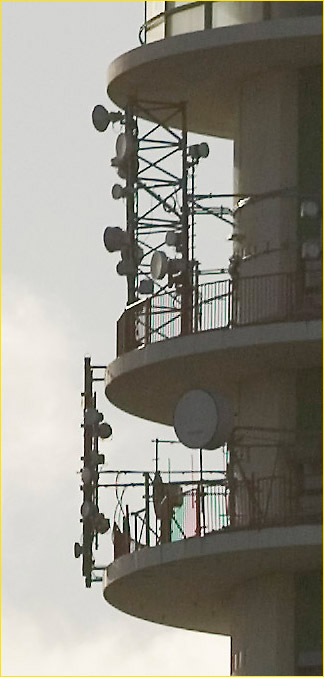
100% Crop
This shows the moire in the more detailed parts of the tower.
The grid on the balconies is just too fine to be ompletely recorded.
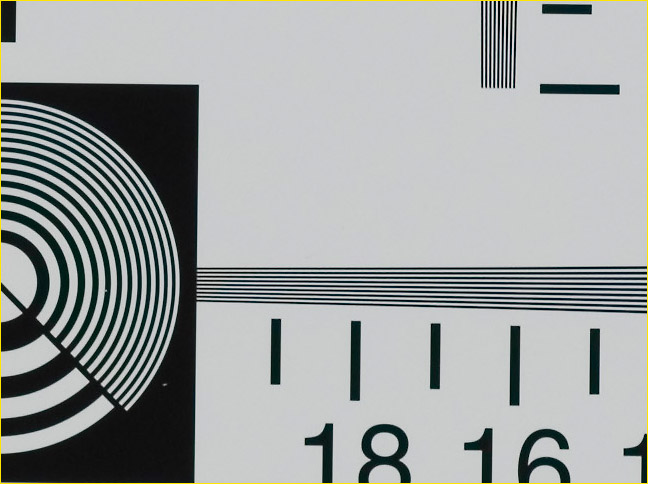
Just for the record and for who are interested –
the standard ISO chart hold no secrets for a Mamiya ZD.
______________________________________________________________________
In March, 2006, as this review was published here, the highly regarded French magazine Chasseur d’Image published their comprehensive review of the Mamiya ZD. I have read it, and also cribbing from one of our discussion forum member’s translation, here are the high points…
– Very high image quality at ISO 100, not so good at higher speeds
– Very poor JPG quality
– Poor rear LCD
– Good handling and viewfinder
______________________________________________________________________
You may also wish to readThe Mamiya ZD Saga
______________________________________________________________________
You May Also Enjoy...
How Emerging Technology Advances Creativity Part III
The previous article highlighted three characteristics of new sensor technology that greatly improve image quality, and which in turn enabled creation of images that I
